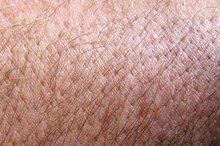Foot and Leg Discoloration
Foot and leg discoloration can be caused by a variety of ailments. These include skin infections, peripheral vascular disease, Schamberg's Disease and diabetes 2. The seriousness of the foot and leg discoloration ranges based on the cause.
If you are experiencing serious medical symptoms, seek emergency treatment immediately.
Skin Infections
Infections of the skin commonly cause foot and leg discoloration, and one of the most common is cellulitis. Staph and strep strains of bacteria cause cellulitis when bacteria enter broken skin through cuts, scrapes, bites or other similar injury. The infected skin turns into blotchy patches of red or darker shades resembling a bruise. Cellulitis is treated with antibiotics, but the discoloration may linger after the treatment. The discoloration can be treated with topical bleaching agents.
- Infections of the skin commonly cause foot and leg discoloration, and one of the most common is cellulitis.
- Cellulitis is treated with antibiotics, but the discoloration may linger after the treatment.
Peripheral Vascular Disease
Rashlike Pigmentation on the Foot
Learn More
Peripheral vascular disease (PVD) encompasses a variety of separate conditions affecting the veins and/or arteries in the extremities 1. The legs and feet are often affected. Discoloration comes in the form of shiny, brittle skin, as well as reddish-blue areas. Bruising and the accompanying discoloration is common with PVD, as is gangrene. Risk factors for developing PVD include obesity, family history and smoking. Treatment involves identifying any underlying cause and prescribing prescriptions for better blood flow.
- Peripheral vascular disease (PVD) encompasses a variety of separate conditions affecting the veins and/or arteries in the extremities 1.
- Bruising and the accompanying discoloration is common with PVD, as is gangrene.
Schamberg's Disease
Patients with Schamberg's Disease have a chronic condition in which blood-vessel walls leak red blood cells into the skin.The cells' presence causes the development of orange and brown irregular splotches that frequently expand over time 2. The exact cause of Schamberg's Disease is unknown, and there is no cure, but any secondary itching can be treated with cortisone cream 2.
Diabetes
Causes of Tingling in the Leg & Foot
Learn More
Diabetics can experience a number of skin discoloration in the legs and feet. These discolorations are symptoms of greater problems and indicate impeded blood flow or insulin rejection. Discoloration in these instances is usually a dark brown or tan color. Gangrene is a more serious discoloration issue common to diabetics, and is caused by the death of tissue. The color progression of gangrene begins red, proceeds to brown and ends up black. In addition to discoloration, the affected areas will be numb and cool to the touch. Treatment of gangrene depends on the stage it is discovered; amputation is usually only necessary for the final stages.
- Diabetics can experience a number of skin discoloration in the legs and feet.
- These discolorations are symptoms of greater problems and indicate impeded blood flow or insulin rejection.
Warning
With the exception of Schamberg's Disease, these conditions can be fatal if left untreated 2. Sudden discoloration in the extremities is a symptom that should be taken seriously. Seek medical supervision immediately if discoloration occurs.
- With the exception of Schamberg's Disease, these conditions can be fatal if left untreated 2.
- Sudden discoloration in the extremities is a symptom that should be taken seriously.
Related Articles
References
- The University of Chicago Medical Center: Peripheral Vascular Disease
- The Skin Site: Schamberg's Disease
- Dermatology Nursing Essentials: A Core Curriculum; Marcia J. Hill; Dermatology Nurses' Association; 2003
Writer Bio
Since 1994 Carrie Glossmanz has been writing freelance articles for publications such as "Animal Fair," "Delicious Living" and "Diabetes Health." Glossmanz is a Registered Dietitian and earned her Master of Science in nutritional sciences with an emphasis on clinical nutrition from the University of Kentucky.









